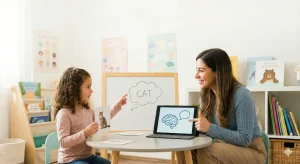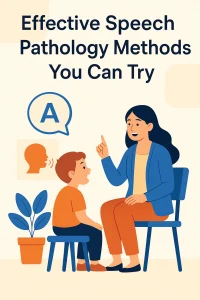15 Proven Techniques to Improve Speech Fluency Fast
Last Updated: June 8, 2024
Fluent speech plays a crucial role in our ability to communicate effectively. It impacts our social interactions, educational achievements, and professional success. When we speak fluently, we can express our thoughts and ideas clearly, connect with others more easily, and build stronger relationships. However, achieving fluent speech can be challenging for some individuals due to various reasons such as developmental delays, speech disorders, or simply needing more practice.
These techniques are easy to implement and can make a significant difference in improving speech clarity and confidence. Whether you are a parent looking to support your child’s speech development, an adult working on your own speech fluency, or a speech therapist seeking effective strategies for your clients, these tips are tailored to meet your needs.
Learn more on Fluency Shaping Tips and Techniques to Overcome Stuttering
1. Simplify Your Language
Simplifying your language is one of the most effective ways to enhance speech fluency. By using short phrases and simple sentences, you make it easier for the listener to understand and for the speaker to express themselves clearly. This technique is particularly helpful for children and individuals with speech difficulties, as it reduces the cognitive load required to process and produce language.
Example: Instead of saying, “Please put your toys in the box,” you can simplify it to “Toys in box.” This straightforward instruction is easier to comprehend and follow.
Simplifying your language doesn’t mean dumbing it down; it means making communication more accessible. Over time, as the individual becomes more comfortable with simpler phrases, you can gradually increase the complexity.
2. Add One Word
Another powerful technique to enhance speech fluency is to add one word to what the person says. This method helps expand their vocabulary and encourages them to use more complex language structures.
Example: If the person says, “want cookie,” you can respond with, “want more cookie.” By adding the word “more,” you are modeling a slightly more complex sentence structure, which can help the individual learn to express more detailed thoughts.
3. Imitation Game
Encouraging imitation is a powerful technique to help individuals improve their speech fluency. By mimicking your speech, they learn proper pronunciation, rhythm, and intonation. Turning this practice into a fun game, like “copycat,” makes the learning process enjoyable and engaging.
How to Play:
- Start with simple sounds or words and ask the person to repeat after you.
- Gradually increase the complexity as they become more comfortable.
- Make it a playful activity by using exaggerated expressions and tones.
Example:
- You say, “Hello,” and they repeat, “Hello.”
- You say, “Good morning,” with a cheerful tone, and they mimic your tone and words.
This game not only builds speech fluency but also strengthens the bond between you and the learner through shared fun and laughter.
4. Offer Choices
Offering choices is an excellent way to encourage decision-making and verbal expression. By providing options, you prompt the individual to use their speech to communicate preferences. This method can be particularly useful for children or those with limited verbal skills.
How to Implement:
- Present two or more options and ask them to choose.
- Ensure the choices are simple and clear.
Example:
- Ask, “Do you want an apple or a banana?”
- Wait for their response and acknowledge it, reinforcing their decision-making.
5. Use Self-Talk
Self-talk is a powerful technique where you narrate your actions out loud. This method helps individuals, especially children, learn new words and phrases by hearing them in context. By describing what you are doing, you provide a model for how language can be used to describe actions and surroundings.
How to Implement:
- Simply talk out loud about what you are doing as you do it.
- Use clear, simple language and emphasize keywords.
Example:
- While washing the dishes, say, “I am washing the dishes. First, I rinse the plate. Now, I scrub with the sponge.”
This constant exposure to language helps reinforce vocabulary and sentence structure, making it easier for the individual to mimic and eventually use these phrases independently.
6. Parallel Talk
Parallel talk is similar to self-talk but focuses on narrating what the other person is doing. This technique helps individuals associate words with their actions, enhancing their understanding and use of language.
How to Implement:
- Observe what the person is doing and describe it out loud.
- Keep your language simple and relevant to their actions.
Example:
- If the person is playing with a toy car, say, “You are playing with the red car. The car is going fast. Now it’s going up the ramp.”
7. Repetition for Reinforcement
Repetition is a fundamental technique in speech therapy that helps reinforce learning and improve fluency. By repeating keywords and phrases multiple times, individuals can better retain new vocabulary and understand its usage in different contexts. This technique is particularly effective for children and those with speech delays, as it provides continuous exposure to language.
How to Implement:
- Choose a keyword or phrase relevant to the activity.
- Repeat it several times in different contexts to reinforce understanding and usage.
Example:
- If you are playing with a ball, you might say, “Ball. This is a ball. Red ball. Let’s roll the ball.”
Repetition helps cement the word in the individual’s memory, making it easier for them to recall and use it independently.
8. Create Opportunities to Speak
Creating opportunities for verbal interaction is essential for improving speech fluency. By setting up situations that require the individual to speak, you encourage them to practice using language in a meaningful way. This technique can be particularly effective in everyday activities and play.
How to Implement:
- Place desired objects just out of reach, so the individual has to ask for them.
- Prompt them to use their words to express their needs and desires.
Example:
- Keep toys on a high shelf so the child has to say, “Can I have the car?” or “I want the doll.”
9. Visual Aids
Using visual aids is a highly effective strategy to support understanding and enhance speech fluency. Pictures and objects provide a concrete reference for words, making it easier for individuals to grasp and remember new vocabulary. This technique is especially useful for visual learners and young children.
How to Implement:
- Incorporate pictures, flashcards, or real objects when teaching new words.
- Consistently pair the visual aid with the spoken word to reinforce the connection.
Example:
- When teaching the word “dog,” show a picture of a dog or use a toy dog. Say, “This is a dog. Dog.”
Visual aids make abstract concepts tangible, helping individuals understand and retain new information more effectively.
10. Use Sabotage Tactics
Sabotage tactics are a clever way to prompt speech and encourage communication. By intentionally withholding something the individual wants or needs, you create a situation where they must use their words to request it. This technique not only motivates speech but also teaches problem-solving and social communication skills.
How to Implement:
- Identify an item or activity the individual is interested in.
- Withhold a key part of the item or activity, prompting them to ask for it.
Example:
- Give them a plate but no food. They will need to say, “I need food,” or “Where is my food?”
11. Be Playfully Forgetful
Being playfully forgetful is a fun and effective way to encourage individuals to use their speech to correct you. This technique turns learning into a game and helps build confidence in speaking.
How to Implement:
- Pretend to forget where an item is or what the next step in an activity is.
- Encourage the individual to correct you or remind you.
Example:
- Say, “Where did I put the spoon? Oh, you have it!”
This playful interaction prompts them to use their language skills in a relaxed and enjoyable manner, reinforcing their speech fluency.
12. Follow Their Lead
Following the individual’s lead means engaging in activities they show interest in and talking about what they are focused on. This technique makes the learning process more relevant and enjoyable for them.
How to Implement:
- Observe what the individual is interested in and join in.
- Talk about the activity they are engaged in, using descriptive language.
Example:
- If they are building with blocks, you might say, “You are stacking the blue block on the red block. What are you building?”
13. Verbal Routines
Using consistent phrases for regular activities helps individuals anticipate what is coming next and prepares them to participate. Verbal routines create a predictable structure, making it easier for them to understand and use language.
How to Implement:
- Develop simple, consistent phrases for routine activities.
- Use these phrases consistently to build familiarity.
Example:
- Before starting a game, always say, “1, 2, 3, go!”
This consistency helps reinforce language patterns and boosts confidence in communication.
14. Singing and Music
Incorporating songs and music into speech therapy can make learning both fun and effective. Music engages multiple areas of the brain, making it an excellent tool for reinforcing language and speech skills. Singing simple songs can help individuals practice pronunciation, rhythm, and new vocabulary in a joyful and memorable way.
How to Implement:
- Choose simple, repetitive songs that are easy to sing along with.
- Encourage the individual to join in, clap along, or even add their own verses.
Example:
- Sing “Twinkle, Twinkle, Little Star” and encourage them to sing along. You can also modify the song to include new words or names.
Using music and singing in your sessions can enhance engagement and make the learning process more enjoyable. This method can be especially beneficial for young children who naturally respond to rhythm and melody.
15. Wait and Listen
Waiting and listening are crucial components of effective communication. By giving the individual time to respond without interrupting, you show respect for their thoughts and encourage them to express themselves more fully. This technique helps build confidence and allows them to organize their thoughts before speaking.
How to Implement:
- Ask a question or make a statement, then pause and wait patiently for a response.
- Avoid interrupting or finishing their sentences for them.
Example:
- Ask, “What did you do at school today?” and give them ample time to answer. Show patience and attentiveness by maintaining eye contact and nodding encouragingly.
Summary of 15 Techniques
| Technique | Description | Example |
|---|---|---|
| Simplify Language | Use short phrases and simple sentences. | “Toys in box.” |
| Add One Word | Expand on what the person says by adding one word. | “Want more cookie.” |
| Imitation Game | Encourage them to mimic your speech. | “Copycat game.” |
| Offer Choices | Give options to encourage decision-making. | “Apple or banana?” |
| Self-Talk | Narrate your actions to model language use. | “I am washing dishes.” |
| Parallel Talk | Describe what the person is doing. | “You are playing with the red car.” |
| Repetition for Reinforcement | Intentionally withholding something they want to prompt speech. | “Ball. This is a ball. Red ball.” |
| Create Opportunities to Speak | Set up situations that require verbal interaction. | Keep toys out of reach. |
| Visual Aids | Use pictures and objects to support understanding. | Show a picture of a dog when saying “dog.” |
| Use Sabotage Tactics | Intentionally withhold something they want to prompt speech. | Give a plate but no food. |
| Be Playfully Forgetful | Pretend to forget something to encourage them to correct you. | “Where did I put the spoon? Oh, you have it!” |
| Follow Their Lead | Engage in activities they show interest in. | Talk about what they are focused on. |
| Verbal Routines | Use consistent phrases for regular activities. | Always say “1, 2, 3, go!” before starting a game. |
| Singing and Music | Incorporate songs to make learning fun. | Sing simple songs and encourage them to join. |
| Wait and Listen | Give them time to respond without interrupting. | Show patience and let them finish their thoughts. |
Also read: 8 Effective Speech Therapy Practices for Kids with Autism
Conclusion
Improving speech fluency takes patience, consistency, and the right techniques. By using these 15 powerful methods, you can create a supportive environment that encourages clear and confident communication. Simple strategies like using shorter sentences, self-talk, visual aids, and incorporating music can make a big difference in speech development.
Remember, progress happens at different speeds for everyone. Consistent practice is key to reinforcing new skills and building confidence. Be patient and celebrate small successes along the way. For more personalized guidance, Wellness Hub’s online speech therapy services offer tailored support to help improve communication skills. Stay committed and use these techniques to unlock the full potential of fluent speech. Thank you for reading, and good luck on your journey to better communication.
Frequently Asked Questions:
1. What are some effective techniques to improve speech fluency?
Effective techniques to improve speech fluency include simplifying your language, using self-talk, incorporating visual aids, and engaging with music. These methods create a supportive environment for enhancing communication skills.
2. How can I help my child with speech development at home?
You can help your child with speech development by using techniques such as self-talk, parallel talk, repetition, and creating opportunities for them to speak. Engage in activities they enjoy and use consistent verbal routines.
3. What is the role of visual aids in speech therapy?
Visual aids play a crucial role in speech therapy by providing concrete references for words. Using pictures and objects helps individuals understand and remember new vocabulary more effectively.
4. How does singing and music benefit speech therapy?
Singing and music engage multiple areas of the brain, making them excellent tools for speech therapy. They help with pronunciation, rhythm, and vocabulary in a fun and memorable way.
5. Why is patience important in improving speech fluency?
Patience is important because progress in speech fluency varies from person to person. Consistent practice and a supportive environment are key to reinforcing new skills and building confidence over time.
6. How can I create opportunities for my child to practice speaking?
You can create opportunities for your child to practice speaking by placing desired objects out of reach so they need to ask for them. Engage in interactive activities that require verbal communication.
7. What is self-talk, and how can it help with speech development?
Self-talk involves narrating your actions out loud to model language use. It helps individuals learn new words and phrases in context, making it easier for them to mimic and eventually use these phrases independently.
8. How do sabotage tactics work in speech therapy?
Sabotage tactics involve intentionally withholding something the individual wants to prompt them to use their speech. This method encourages communication by creating a natural need for verbal interaction.
9. Can these speech therapy techniques be used for adults?
Yes, these speech therapy techniques can be adapted for adults as well. Techniques like visual aids, repetition, and creating opportunities for verbal interaction are beneficial for individuals of all ages.
10. Where can I find more personalized speech therapy support?
For personalized speech therapy support, visit Wellness Hub’s online speech therapy services. Our expert therapists offer tailored plans to meet specific needs and goals.
About the Author:
Anuradha Karanam
Speech-language pathologist (7+ years of experience)
Anuradha Karanam is a skilled speech-language pathologist with over 6 years of experience. Fluent in Tamil, Telugu, Hindi, and English, she specializes in parent counseling, speech sound disorders, fluency assessment, and speech-language evaluations. Anuradha excels at working with children with developmental disorders, offering creative and effective therapy programs. Currently, at Wellness Hub, she holds a BASLP degree and is registered with the RCI (CRR No A85500). Her patience, ambition, and dedication make her a trusted expert in her field.
Connect with Anuradha to learn more about how she can help you or your loved one find their voice.
Book your Free Consultation Today
Parent/Caregiver Info:
Client’s Details:
* Error Message









